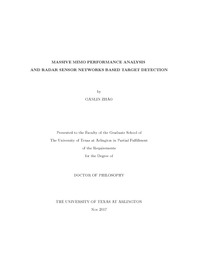
ATTENTION: The works hosted here are being migrated to a new repository that will consolidate resources, improve discoverability, and better show UTA's research impact on the global community. We will update authors as the migration progresses. Please see MavMatrix for more information.
Show simple item record
| dc.contributor.advisor | Liang, Qilian | |
| dc.creator | Zhao, Ganlin | |
| dc.date.accessioned | 2018-02-15T20:27:25Z | |
| dc.date.available | 2018-02-15T20:27:25Z | |
| dc.date.created | 2017-12 | |
| dc.date.issued | 2017-12-08 | |
| dc.date.submitted | December 2017 | |
| dc.identifier.uri | http://hdl.handle.net/10106/27177 | |
| dc.description.abstract | In this dissertation, we apply massive multiple-input-multiple-output (MIMO) performance analysis and radar target detection based on radar sensor networks(RSN). In recent years, massive MIMO draws great interest for wireless communication re- searchers. As a highly scalable technology for 5G networks, massive MIMO will meet the increasing demand for wireless throughput. Also, radar target detection is also an important topic for military and civilian applications. Improving detection accuracy when target is embedded in strong background clutter is a challenging task.
In Chapter 2, we investigate scaling law of theoretical transmission capacity limit in an uplink multi-user MIMO system. In 5G network base station densification and massive MIMO are both important techlogogies which explore the spatial reuse and diversity to increase the total network spectrum efficiency. We apply scaling law to conduct the asymptotic analysis on how the outage capacity scales with number of users, base stations and base station antennas.
In Chapter 3, we investigate shadow fading impact on a multi-user massive MIMO system. By deploying a large antenna array on the base station, the random channel vectors between users and base station antennas become pairwise orthogonal. This important property of massive MIMO makes small scale fading effect asymptotically vanish while large scale fading still remains. Based on this fact, we analyze the uplink achievable rate and cell coverage area under outage constraint considering log-normal shadow fading effect for both single-cell and multi-cell scenarios.
In Chapter 4, we propose an Empirical Mode Decomposition (EMD) based approach to Ultra Wide Band (UWB) radar for sense-through-foliage target detection. When the radar signal quality is good, the EMD based target detection approach performs well by comparing to the no target case. When the radar signal quality is poor and a single radar echo fails to detect the target, we firstly apply RSN and Rake structure to combine radar echoes from different radar cluster-members and then the EMD based method could successfully carry out the target detection.
In Chapter 5, we propose a target detection and classification approach using Hidden Markov Models (HMMs). Hidden Markov Model is used as an classifier to distinguish between the presence of target in a background clutter and the pure clutter response. Sense-through-foliage target detection and Sense-through-Wall human detection are conducted using real world Ultra Wide Band (UWB) data. Experiment results show HMM based method provides good detection and false alarm rate for poor quality radar echoes in position 1 in the sense-through-foliage target detection scenario. Sense-through-wall human experiment results shows Hidden Markov Model based method could successfully detect stationary human target behind different types of walls. | |
| dc.format.mimetype | application/pdf | |
| dc.language.iso | en_US | |
| dc.subject | Massive MIMO | |
| dc.subject | Outage | |
| dc.subject | Radar target detection | |
| dc.subject | UWB | |
| dc.subject | EMD | |
| dc.subject | HMM | |
| dc.title | MASSIVE MIMO PERFORMANCE ANALYSIS AND RADAR SENSOR NETWORKS BASED TARGET DETECTION | |
| dc.type | Thesis | |
| dc.degree.department | Electrical Engineering | |
| dc.degree.name | Doctor of Philosophy in Electrical Engineering | |
| dc.date.updated | 2018-02-15T20:29:32Z | |
| thesis.degree.department | Electrical Engineering | |
| thesis.degree.grantor | The University of Texas at Arlington | |
| thesis.degree.level | Doctoral | |
| thesis.degree.name | Doctor of Philosophy in Electrical Engineering | |
| dc.type.material | text | |
Files in this item
- Name:
- ZHAO-DISSERTATION-2017.pdf
- Size:
- 9.832Mb
- Format:
- PDF
This item appears in the following Collection(s)
Show simple item record


